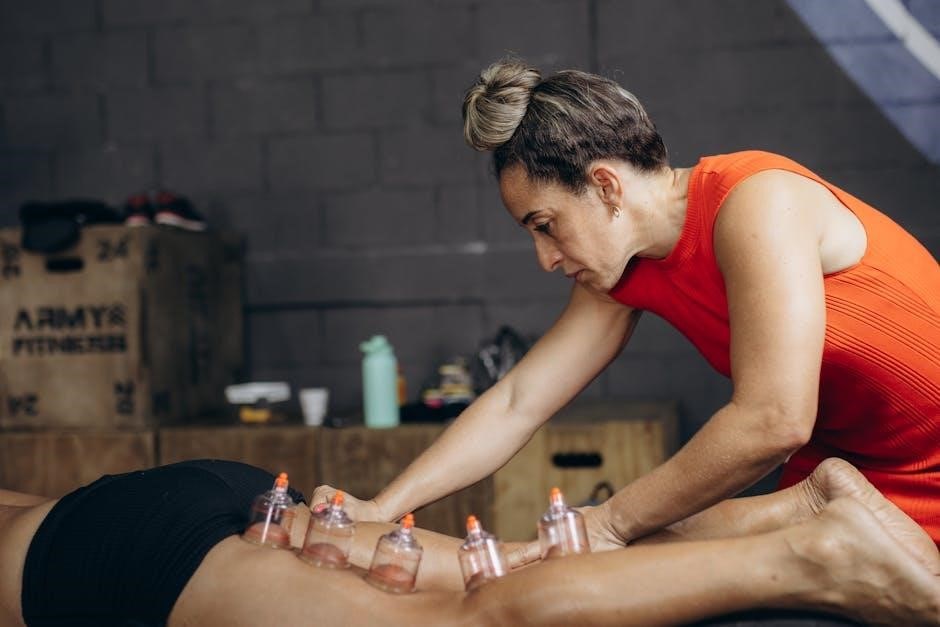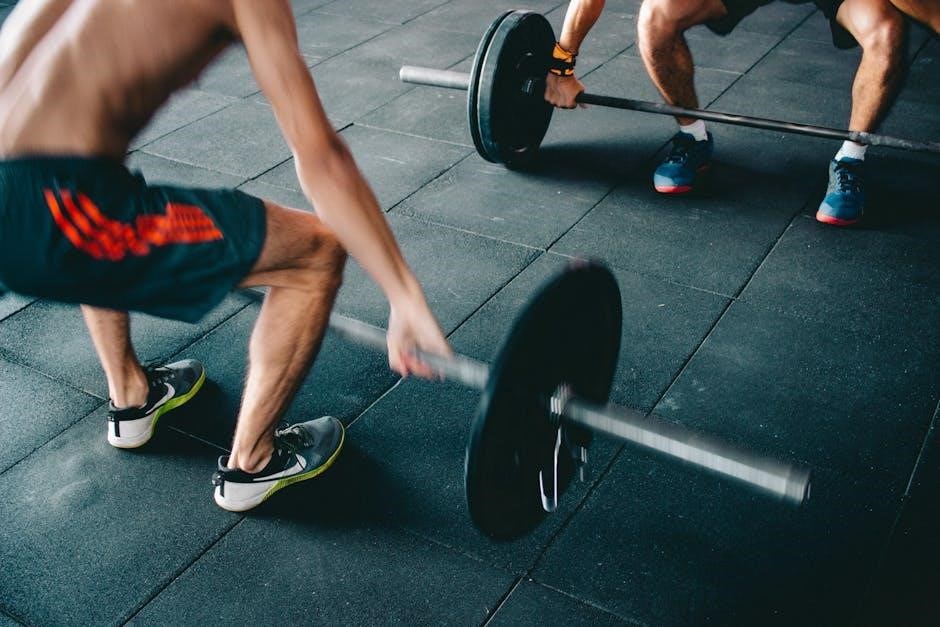The psoas major muscle plays a crucial role in hip flexion and spinal stability. Strengthening it through targeted exercises like pelvic tilts and leg raises can improve posture, reduce lower back pain, and enhance overall mobility. Incorporating core engagement and proper form is essential for effective results. Regular practice helps maintain muscle balance and prevents injuries, making it a vital component of any fitness or rehabilitation routine.
1.1 Understanding the Psoas Muscle and Its Role
The psoas major muscle is a deep, long muscle in the lower back that plays a critical role in hip flexion and spinal stabilization. Originating from the lumbar spine (T12-L4) and inserting into the femur, it facilitates movements like walking, running, and sitting. The psoas works synergistically with the iliacus muscle to lift the thigh and maintain posture. Its proper function is essential for balance, mobility, and reducing the risk of lower back pain. Strengthening this muscle enhances overall stability and movement efficiency.
1.2 Importance of Psoas Strengthening for Overall Mobility
Strengthening the psoas muscle is vital for maintaining proper posture, reducing lower back pain, and enhancing mobility. Weak or tight psoas muscles can lead to imbalances, affecting gait and spinal alignment. Regular exercises targeting the psoas improve hip flexion strength, reducing the risk of injury and enhancing athletic performance. This muscle’s role in stabilizing the spine makes its strengthening essential for overall physical function, ensuring efficient movement and preventing long-term musculoskeletal issues.
Benefits of Psoas Strengthening
Strengthening the psoas improves posture, reduces lower back pain, and enhances balance. It boosts athletic performance and prevents injuries, promoting overall mobility and muscle balance.
2.1 Improved Posture and Reduced Lower Back Pain
Strengthening the psoas muscle can significantly enhance posture by stabilizing the spine and pelvis. This leads to reduced lower back pain, as the psoas helps maintain proper spinal alignment during movements. Weak or tight psoas muscles often contribute to poor posture and discomfort, making targeted exercises essential for long-term relief and improved spinal health.
2.2 Enhanced Athletic Performance and Balance
Strengthening the psoas muscle enhances athletic performance by improving power, speed, and endurance. It supports hip flexion and stability, crucial for activities like sprinting, jumping, and quick directional changes. A strong psoas also boosts balance and coordination, reducing the risk of injuries during dynamic movements. By integrating psoas exercises into training, athletes can achieve greater overall physical performance and maintain optimal muscle balance for peak conditioning.
2.3 Prevention of Injuries and Muscle Imbalances
Strengthening the psoas helps prevent injuries by stabilizing the hips and lower back. Weak or tight psoas muscles can lead to muscle imbalances, increasing the risk of strains and poor posture. Regular psoas exercises promote balanced hip flexor strength, reducing the likelihood of overuse injuries in activities like running or cycling. Proper activation and flexibility ensure harmonious muscle function, safeguarding against chronic issues and enhancing overall athletic resilience and mobility.
Key Principles for Effective Psoas Strengthening
Proper form, progressive overload, and consistency are essential for effective psoas strengthening. Incorporating core engagement ensures balanced muscle activation, promoting stability and reducing injury risk.
3.1 Proper Form and Technique
Maintaining proper form is critical for effective psoas strengthening. Focus on controlled movements, avoiding overextension or strain. Engage the core to stabilize the body, ensuring the psoas muscle is activated correctly. Practice exercises like pelvic tilts and leg raises with precision, keeping the lower back neutral. Improper technique can lead to muscle imbalances or injury, so prioritize slow, deliberate movements and seek guidance if needed to master the exercises.
3.2 Progressive Overload and Consistency
Progressive overload is essential for building psoas strength over time. Gradually increase exercise intensity by adding resistance or repetitions to challenge the muscle effectively. Consistency is key; aim to practice psoas-strengthening exercises 2-3 times weekly. Overloading too quickly can risk injury, so focus on steady, manageable progress. Regular practice ensures continuous improvement, helping to maintain muscle balance and enhance overall mobility. Patience and persistence are vital for achieving long-term benefits from psoas strengthening routines.
3.3 Incorporating Core Engagement
Engaging the core during psoas exercises enhances stability and ensures proper muscle activation. Activate abdominal muscles by drawing the navel toward the spine before and during movements. This prevents overreliance on secondary muscles and promotes efficient energy transfer. Core engagement improves posture, reduces injury risk, and maximizes the effectiveness of exercises like pelvic tilts and leg raises. Strong core-psoas coordination is essential for optimal mobility and athletic performance, making it a cornerstone of effective strengthening routines.

Best Exercises for Psoas Strengthening
Pelvic tilts and single-leg raises are excellent for targeting the psoas. Wall mini-squats and physioball exercises also effectively engage the muscle, improving hip mobility and spinal stability.
4.1 Pelvic Tilts and Rotational Exercises
Pelvic tilts and rotational exercises target the psoas muscle, enhancing flexibility and spinal stability. Lie on your back, tilt your pelvis upward, and hold for 5-10 seconds. Rotational movements involve rolling your hips side-to-side and drawing figure-8 patterns. These exercises strengthen the psoas and improve hip mobility. Start with controlled, small ranges and gradually increase as comfort allows. Incorporate core engagement to maximize effectiveness and prevent strain. Regular practice promotes better posture and reduces lower back tension.
4.2 Single-Leg Raises and Bent Leg Raises
Single-leg raises and bent leg raises are effective for targeting the psoas muscle. Lie on your back, extend one leg, and lift it 6-8 inches, holding for 5 seconds. For bent leg raises, lift the entire leg, keeping the knee bent at 90 degrees. These exercises improve balance, strength, and muscle activation. Start with 3 sets of 10-12 repetitions on each leg. Focus on controlled movements to avoid strain and maximize psoas engagement. Regular practice enhances hip mobility and overall stability.
- Begin with slow, deliberate motions.
- Engage core muscles for support.
- Gradually increase repetitions as strength improves.

4.3 Wall Mini-Squats and Physioball Exercises
Wall mini-squats and physioball exercises are excellent for strengthening the psoas while reducing strain on the lower back. Stand with your back against a wall and slide down, holding for 10 seconds. For physioball exercises, lie on the ball, engage your core, and perform slow, controlled leg raises. These exercises promote proper form, enhance muscle activation, and improve hip mobility. Start with 3 sets of 10-12 repetitions, ensuring controlled movements to target the psoas effectively without overexertion.

Stretching Exercises to Complement Strengthening
Stretching is essential for maintaining psoas flexibility and preventing tightness. Incorporate knee-to-chest stretches, hip flexor stretches, and figure-8 hip movements to enhance mobility and reduce muscle tension effectively.
5.1 Knee-to-Chest Stretch for Flexibility
The knee-to-chest stretch is a simple yet effective exercise for improving psoas flexibility. Lie on your back with legs straight, then bring one knee toward your chest while keeping the other foot flat on the floor. Hold for 20-30 seconds and repeat 2-3 times on each side. This stretch helps lengthen the psoas muscle, reducing tightness and enhancing hip mobility. It is recommended to perform this stretch 2-3 times daily, especially during the initial stages of a strengthening program.
5.2 Hip Flexor Stretch Variations
Hip flexor stretches are essential for maintaining psoas flexibility. One variation involves kneeling on one leg with the other foot in front, leaning forward slightly to stretch the front of the hip. Another variation is the standing stretch, where you pull one knee toward your chest while standing. These stretches target the iliopsoas and other hip flexors, improving range of motion and reducing muscle tension. Perform 2-3 sets daily for optimal results, especially after strengthening exercises.
5.3 Figure-8 Hip Movements for Mobility
Figure-8 hip movements enhance psoas flexibility and hip joint mobility. Lie on your back with knees bent and feet flat on the floor. Gently move your hips in a figure-8 pattern, first clockwise and then counterclockwise. Perform 6 repetitions in each direction. Incorporate Kegel exercises by squeezing your sit bones at the end of each movement. This exercise improves coordination, reduces stiffness, and complements psoas strengthening by promoting balanced muscle engagement and overall hip health.

Advanced Techniques for Psoas Activation
Advanced techniques like constructive rest, isometric holds, and controlled pelvic movements enhance psoas activation. These methods improve muscle engagement, core stability, and overall hip mobility effectively.
6.1 Constructive Rest and Isometric Holds
Constructive rest involves lying supine with knees bent, feet flat, and hips neutral. Isometric holds strengthen the psoas by contracting and holding the muscle without movement. Start with 5-10 second holds, gradually increasing duration. This technique improves core stability and promotes balanced muscle activation. It’s ideal for those recovering from injuries or seeking low-impact strengthening. Regular practice enhances psoas function and overall lower back health effectively.
6.2 Elevated Bent Leg Raises
Elevated bent leg raises target the psoas major by lifting the legs while engaging the core. Lie on your back with legs bent at 90 degrees and feet elevated. Slowly lower one leg toward the floor while maintaining a neutral pelvis, then raise it back. This exercise enhances psoas strength and hip stability; Focus on controlled movements to avoid strain. Regular practice improves lower back support and overall hip mobility effectively.
6.3 Controlled Pelvic Movements and Kegel Exercises
Controlled pelvic movements and Kegel exercises enhance psoas activation by synchronizing core engagement with pelvic tilts. Lie on your back, tilt your pelvis upward, and hold for 5 seconds. Incorporate Kegels by squeezing the pelvic floor muscles during the movement. This combination strengthens the psoas, improves posture, and enhances lower back stability. Practice 3 sets of 10 repetitions daily for optimal results and improved muscle coordination. Consistency is key to achieving long-term benefits.

Incorporating Core Strengthening Exercises
Incorporating core-strengthening exercises enhances psoas function by improving spinal stability and posture. Planks, ball squats, and Pilates-inspired movements help integrate core strength with psoas activation for better mobility and balance.
7.1 Plank Variations for Core Stability
Plank variations are a key component of core strengthening, enhancing spinal stability and posture. Engage your psoas by drawing your belly button toward your spine during planks. Start with a forearm plank, activating your transverse abdominis muscle. Progress to stability exercises on a physioball or with leg lifts for added challenge. Proper breathing and alignment are crucial to avoid straining. Incorporate side planks to target obliques and improve overall core integration. Begin with shorter holds and gradually increase duration as strength improves.
7.2 Ball Squats and Gluteal Activation
Ball squats are excellent for engaging the glutes and psoas while improving core stability. Stand with your back against a physioball, feet shoulder-width apart. Slowly lower into a squat, maintaining contact with the ball. Activate your glutes and psoas by squeezing as you rise. Incorporate cocontraction of abdominal muscles for enhanced stability. This exercise promotes proper muscle activation patterns and strengthens the lower extremities. Start with controlled movements and progress gradually to avoid strain.
7.3 Pilates-Inspired Movements for Full-Body Integration
Pilates-inspired movements integrate the psoas with core and gluteal activation, promoting full-body coordination. Exercises like the “Hundred” and “Teaser” focus on controlled movements, engaging the psoas while strengthening the abdominal muscles. These flows enhance posture, balance, and overall stability. By linking breath with movement, Pilates-inspired techniques ensure efficient muscle activation, fostering a harmonious connection between the psoas, core, and extremities for improved mobility and strength.

Common Mistakes to Avoid in Psoas Exercises
Overreliance on secondary muscles, poor breathing techniques, and excessive repetition without rest are common mistakes. Focus on proper form, core engagement, and balanced progression to avoid injury.
8.1 Overreliance on Secondary Muscles
Overreliance on secondary muscles, such as the quadriceps or lower back, is a common mistake during psoas exercises. This can reduce the effectiveness of the workout and lead to muscle imbalances. To avoid this, focus on isolating the psoas by engaging the core and maintaining proper form. For example, during leg raises, ensure the movement originates from the hips rather than the knees or lower back. This helps target the psoas directly and prevents overcompensation from other muscle groups.
8.2 Ignoring Proper Breathing Techniques
Proper breathing is essential during psoas strengthening exercises to maintain core stability and prevent unnecessary muscle tension. Shallow breathing or holding breath can lead to poor form and reduced effectiveness. Exhale during the exertion phase to engage the core and maintain control. Inhale during the relaxation phase to promote relaxation and proper muscle activation. Avoiding this mistake ensures a safer and more effective workout, enhancing overall muscle engagement and reducing the risk of injury or strain.
8.3 Excessive Repetition Without Rest
Excessive repetition without adequate rest can lead to overtraining and muscle fatigue, reducing the effectiveness of psoas strengthening exercises. Overworking the muscle without recovery time increases the risk of strain or injury. It is crucial to balance repetition with rest days to allow the muscle to repair and strengthen. Incorporating rest days or active recovery, such as stretching or low-impact activities, ensures sustainable progress and prevents muscle imbalances. This approach promotes long-term muscle health and functional improvement.

Sample 4-Week Workout Routine
A structured 4-week plan focusing on foundational exercises, progressive strengthening, and advanced techniques to enhance psoas activation and overall muscle integration, ensuring gradual strength development and injury prevention.
9.1 Week 1: Foundation and Mobility
Week 1 focuses on establishing a strong foundation through basic exercises like pelvic tilts and rotational movements. These exercises improve mobility and prepare the psoas for more intense workouts. Start with gentle stretches and controlled movements, ensuring proper form to avoid strain. Incorporate core engagement to stabilize the body during exercises. Practice 2-3 times weekly, gradually increasing repetitions as comfort allows. This phase sets the stage for progressive strengthening in subsequent weeks.
9.2 Week 2: Progressive Strengthening
In Week 2, focus on gradually increasing the intensity of exercises like wall mini-squats and physioball movements. These exercises target the psoas while engaging the core for stability. Perform 3 sets of 10-12 repetitions, ensuring proper form to avoid strain. Incorporate rotational pelvic exercises and single-leg raises to enhance strength and balance. Practice 3-4 times weekly, monitoring progress and adjusting as needed. This phase builds on the foundation established in Week 1, promoting greater muscle activation and mobility.
9.3 Week 3: Advanced Activation Techniques
Week 3 introduces advanced techniques to enhance psoas activation, such as elevated bent leg raises and controlled pelvic movements. Focus on isometric holds to strengthen endurance. Incorporate Kegel exercises to integrate core and psoas engagement. Perform 3-4 sets of 8-10 repetitions, emphasizing slow, controlled movements. Advanced rotational exercises and figure-8 hip movements improve mobility and strength. Ensure proper form and breathing to maximize results and prevent strain. Consistency is key to achieving optimal muscle activation and improved overall stability.
9.4 Week 4: Full Integration and Maintenance
Week 4 focuses on integrating all exercises into a cohesive routine for long-term maintenance. Combine pelvic tilts, leg raises, and rotational movements with core-strengthening exercises like planks and ball squats. Incorporate dynamic stretches and controlled pelvic movements to enhance mobility. Aim for 3-4 sets of 10-12 repetitions, ensuring smooth transitions between exercises. Maintain consistent practice and gradually increase intensity. Monitor progress and adjust routines as needed to sustain psoas strength, core stability, and overall muscle balance for lasting results and injury prevention.
Additional Considerations
Incorporate props like physioballs and resistance bands for enhanced psoas engagement. Focus on proper breathing and gradual progression to avoid strain. Tailor routines for athletes to improve performance and reduce injury risk.
10.1 Use of Props and Equipment
Using props like physioballs, resistance bands, and wobble cushions can enhance psoas engagement. For example, mini-squats on a physioball target the psoas while improving balance. Resistance bands can add tension during leg raises, strengthening hip flexors. Pelvic tilt exercises with a foam roller or cushion promote controlled movements, reducing strain. These tools help maintain proper form and prevent muscle imbalances, ensuring effective and safe psoas strengthening routines.
10.2 Role of Psoas in Athletes and Active Individuals
The psoas muscle is essential for athletes, as it facilitates powerful hip flexion and stabilizes the spine during dynamic movements. Strengthening the psoas enhances sprinting, jumping, and agility, while reducing injury risk. For active individuals, a strong psoas improves endurance and coordination. Exercises like elevated bent leg raises and controlled pelvic movements are particularly beneficial. Consistent psoas training helps athletes maintain optimal performance and prevent muscle imbalances, making it a cornerstone of sports-specific conditioning and rehabilitation programs.
10.3 Long-Term Maintenance and Prevention
Long-term psoas maintenance requires consistent practice of strengthening and stretching exercises. Incorporating a 10-15 minute daily routine, including pelvic tilts and leg raises, helps sustain flexibility and strength. Preventative measures involve avoiding prolonged sitting and incorporating activities like yoga or Pilates to keep the psoas active. Regular core engagement and proper posture also play a role in maintaining muscle balance and preventing future injuries or tightness. Consistency is key to long-term health and mobility.
Consistency and patience are key to effective psoas strengthening. Incorporate exercises into your daily routine for improved mobility and strength. Stay motivated and celebrate progress, no matter how small;
11.1 Recap of Key Exercises and Principles
Pelvic tilts, single-leg raises, and wall mini-squats are foundational for psoas strengthening. These exercises target hip flexion and spinal stability, improving posture and reducing lower back pain. Proper form and core engagement are essential to avoid overloading secondary muscles. Progressive overload and consistency ensure sustained progress. Incorporate stretching, like the knee-to-chest stretch, to maintain flexibility. Combining these exercises with advanced techniques, such as constructive rest, enhances overall effectiveness. Regular practice and patience yield long-term benefits for mobility and strength.
11.2 Encouragement for Consistent Practice
Consistency is key to achieving lasting benefits from psoas strengthening exercises. Regular practice, even for a few minutes daily, fosters improved posture, reduces lower back pain, and enhances mobility. Set realistic goals and track progress to stay motivated. Celebrate small victories, as gradual improvements lead to long-term results. Stay committed, as consistent effort strengthens the psoas and promotes overall well-being. Remember, patience and dedication are essential for enduring success in your fitness journey.

Resources for Further Learning
Explore detailed guides like “The Psoas Muscles: A Step-by-Step Remedy” and “The Five Minute Hip Flexor Stretch Solution” for comprehensive routines. Visit websites like uhs.princeton.edu for exercise manuals and expert articles. Utilize recommended PDFs and research papers for advanced techniques and case studies to deepen your understanding of psoas strengthening and maintenance.
12.1 Recommended PDF Guides and Worksheets
Download comprehensive PDF guides like “The Psoas Muscles: Simple Step By Step Remedy For Healing Psoas Pains” and “The Five Minute Hip Flexor Stretch Solution” for detailed routines. These resources provide step-by-step exercises, stretching techniques, and strengthening programs. Visit university websites like uhs.princeton.edu for additional exercise manuals and research-based worksheets. Utilize these materials to create a structured plan for psoas strengthening and maintenance, ensuring a well-rounded approach to muscle health and recovery.
12.2 Suggested Reading and Research
Explore research articles by authors like ГН Пономаренко and МР Питкин for in-depth insights into psoas strengthening techniques. Their works highlight the integration of psychophysical exercises into rehabilitation programs, offering practical approaches for muscle recovery and strength building.
Delve into studies published in journals such as “Annals of Rehabilitation Medicine” and “Reanimatology” for evidence-based exercises and case studies on psoas injuries and recovery. These resources provide a scientific foundation for understanding psoas function and optimizing exercise routines for both athletes and individuals with muscle imbalances.
12.3 Expert Opinions and Case Studies
Experts like ГН Пономаренко emphasize the importance of tailored psoas exercises for rehabilitation, highlighting their effectiveness in reducing muscle imbalances. Case studies demonstrate significant improvements in hip flexion strength and reduced lower back pain following consistent practice. Researchers such as МР Питкин provide evidence-based routines that combine strengthening and stretching, showcasing their success in both athletic performance and injury recovery.

No Responses